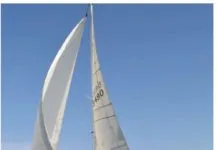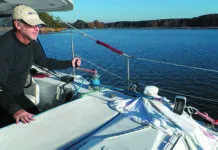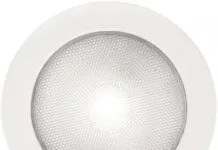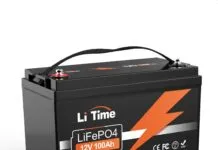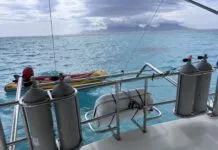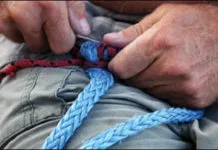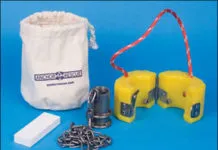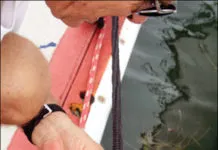Testers Take Tacktick and Nexus Wind Instruments for a Spin
Practical Sailor testers compared Tackticks improved Race Master system to the Nexus Start Pack 3, a hybrid wired/wireless system. The Tacktick Micronet wireless wind instrument, a compact system featuring wireless display and a masthead sensor, has a strong following among racers. It has proven to be a good choice for those sailors serious about improving race performance as it has many options for tracking performance on the course in real time. Its ability to work with a 12-volt system makes it a good choice for small boats. The versatile, expandable Nexus hybrid has an impressive and intuitive interface and a graphic analog wind representation. It provides all of the basic functions a cruiser or racer uses most, and testers found the analog wind display appealing.
Practical Sailor Tests Lightweight Tether Aimed at Racing Sailors
Theres a reason why we recommend safety tethers-the umbilical cords that connect the jacklines on our boats to the harnesses on our bodies-be 6 feet long or shorter. Getting dragged behind a boat, even at the sedate speed of 4 knots, can easily drown a person. Unless someone is on hand to haul you on board, survival relies on a superhuman burst of adrenaline. Though rare, there have been some highly publicized deaths involving harnesses. The story of Harvey Shalsky, a sailor in the 1999 Double-handed Farallones Race, is familiar to most racers. Shalsky, racing with longtime partner Mark Van Selst, drowned while tethered to his J/29 White Lightning. Van Selst was unable to slow the boat or haul his partner in, and eventually cut loose Shalsky (who was by then unconscious) so that following boats could recover him. The hazards associated with a tether that cannot be easily released under load prompted the International Sailing Federation (ISAF, the council responsible for regulating offshore sailing races) to recommend this feature in tether designs. It is not a requirement, only a recommendation, and ISAF does not stipulate what method should be used for the release.
Headsail Furlers Sans Swivels Face-Off
A follow-up to our evaluation of jib furlers with head swivels, Practical Sailor reviews roller furlers that use no swivel. For many years, the Flexible Furler from Cruising Design Inc. (CDI) was the most prominent player in this category, but some new products and innovative designs are offering more options for sailors looking for easy-to-install furling. Along with the CDI furler, we look at four roller-reefing systems: Alado A-2, Spin-Tec Triumph 2000, and Reefurl. Having no upper halyard swivel, these furling systems put the foil sections in compression and use an external halyard system to attach the head of the jib to a built-in halyard or a fitting at the top of the foil system. Although PS regards conventional roller-bearing furlers with top swivels (tested in August 2009) as the most sensible choice for serious offshore cruisers, these alternative jib furlers offer a cost-effective, easy-to-install option.
Practical Sailors Gear of the Year 2009
Practical Sailor editors pored over the dozens of products reviewed in the previous months to find the best of the best sailing gear, products that are worthy of the designation Gear of the Year. This years editors choice list includes a rugged rope clutch (Spinlock), a grippy ratchet block (Ronstan), feature-filled VHF handheld radios (Standard Horizon and Cobra), high-quality nesting cookware (Magma), a proven paste wax (Collinite), an ocean-ready first-aid kit (Adventure Medical Kits), a reliable LED bulb for cabin lighting (Imtra), an economical ice box conversion kit (Frigoboat), an innovative ultrasonic tank sensor (BEP Marine), cold-weather gloves (Gill), and an easy-to-install Wi-Fi booster (5mileWiFi).
Cabin Fan Test Returns
In April 2008, Practical Sailor evaluated 11 cabin fans from seven manufacturers. Since that test, Caframo has gone back to the drawing board and redesigned its 748 Bora. The company also introduced a new weatherproof version of its Kona. Testers were pleased to see that the new fans clearly addressed complaints raised in our last test: The Bora radically changed its blade design to pump more air, and the Konas corrosion-prone metal grill was replaced with a plastic grill that will hold up better in salt air. Based on the new data, the Bora has climbed up into the recommended rankings. Stay tuned for this years Fan Death Match.
Gripping Hitches for Loaded Lines
Testers evaluated five different knots to determine which would be the ideal for holding a tensioned line. Testers considered ease of tying and untying, ease of learning and recall, and holding power with various types of line. The old standard rolling hitch was pitted against the modified rolling hitch, icicle hitch, gripper hitch, and sailors hitch.
Ground Tackle
As Practical Sailor prepares for a new round of anchor tests, weve been on the hunt for new anchors, as well as new accessories. One of the most interesting devices to come our way is the Anchor Rescue developed by Richard Provonchee, a sailor and principal in Boxer Marine Inc., based in Cushing, Maine. The most common complaint about anchors is their lack of holding, but an anchor that refuses to budge-can also have serious consequences. The Anchor Rescue uses an innovative two-part system to free fouled anchors. The typical antidote to fouling is to attach a buoyed line to the anchor crown so that it can be hauled backward out of its snag. Most anchors have an eye at the crown for attaching a buoyed retrieval line. (Danforth-style anchors are an exception).
Mooring Anchors for Sensitive Seabeds
Mooring anchors fall into two general categories: those that rely on sheer weight and mass to provide holding and the embedment types that penetrate the sea floor. There are also some hybrids that rely mostly on their weight, but also embed themselves in the sea floor over time. BoatUS projects and municipal tests on Sarasota Bay, Fla., support helical screws as the best option when it comes to choosing mooring tackle, particularly in sensitive areas. Practical Sailors evaluation of mooring anchor types includes the Helix screw, Manta Ray, Dor-Mor, Mushroom, and concrete blocks.
A Look at the Latest Generation of Genoa Furlers
To get an idea of whats on the market and see how the newer products fare against the simpler, tried and true furling systems, Practical Sailor rounded up 11 new headsail furlers suited for 30- to 35-foot sailboats. This, the first of a two-part report on the evaluation, focuses on the seven products that use a head-swivel design and range in cost from $950 to $3,200. (The report of integral systems will follow in an upcoming issue.) The following furlers were reviewed: Facnor LX 130, Harken MkIV and Cruising 1, Profurl LCI32, Schaefer 2100, Furlex 200S (Selden Mast), and US Spars (Z-Spar) Z-780.
Synergy Dock Line Stands Up in Tests
In July 2008, Practical Sailor looked at products for docking, anchoring, or mooring in a storm. Among those mentioned was the Synergy docking line, an abrasion-resistant polyester braid with a short length of industrial-grade rubber in the core. Synergy also makes a stretchy, floating tow-rope for dinghies. We put Synergy dock lines into use for six months on a fixed dock and during a two-week Mississippi River delivery cruise. They held up as well as similar braided lines and proved to be more convenient to use than its nearest comparison, a dock line with a rubber snubber. One drawback noted was that the woven cover was more prone to snagging than more tightly braided lines.


